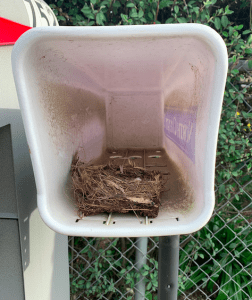Bird Journal Entry #8:
DATE: 3/31/2020
Location: 33.1843, -117.2002 approx.
Site Description:
The place I visited this week was around my friend’s neighborhood on a street called Buena Creek Trail in Vista, California. The street has many trees and the houses have very large plots of land with dense bushes, making it a perfect place for many bird species to inhabit. There were many flowering plants, orange trees, and shrubs present along the path with a various array of tall trees that were dispersed along the properties. The path was very well paved because it was a residential area where most houses had their own private gates. I didn’t expect to see any potentially dangerous animals since we kept to the street, but there were occasional rabbits and lizards along the path. There hadn’t been any rain since the last time, so the environment was very dry. The species I spotted during the 1 hour trip were Band-tailed Pigeons (2), Anna’s Hummingbird (3), Cooper’s Hawk (1), Acorn Woodpecker (3), American Crow (4), Wrentit (10), Western Bluebird (1), House Sparrow (1), Chipping Sparrow (1), White-crowned Sparrow (10), Song Sparrow (1), and a California Towhee (1).
Species Account:
The species I enjoyed seeing this week was Cooper’s Hawk. This species is a medium-sized bird with very long and rounded wing tips. I saw the adult version which has more of a gray backing with red spots running down it’s chest. I saw streaks of red coloring as it flew away because the coloring runs along the legs as well. It was very poised and was simply sitting on a telephone line observing the sky. The hallux was extremely prominent because of the bright yellow coloring of the legs. They live in a range of areas from thick forests to people’s. I noticed that the flight pattern was not consistent and had a period of flapping and then gliding. The bird only flew about 100 yards before it landed again, but it was obstructed from a clear view because trees were blocking it. They usually hunt their prey by first stalking it from above the ground and then quickly moving in on it before the bird or other small mammal has a chance to escape. There are usually between 3-5 eggs that are produced at one time from the female and when they are young the male bird searches for food to bring back to the nest for his young. One fact that I found cool about this hawk species was their nests are built very dense and large, so it can be occupied by both the male and female.
Narrative:
This week for birding I chose to go around my best friend’s neighborhood. Don’t worry we were social distancing always walking 6 feet apart. Her neighborhood is about a 2 1/2 miles and we walked around, so we could observe all the birds in the area. This birding adventure lasted around an hour. It was partly cloudy outside and about 66 degrees. We decided to take the trip later on in the afternoon around 4:30 p.m. PST and as we were walking around we saw a chipping sparrow which was very cool because she had seen them a lot around her neighborhood, but didn’t know exactly what kind of bird it was. I was very excited that she was finally able to ID it. As we walked further we saw Anna’s Hummingbird which is very easy to identify no because of the pinkish/reddish undertone around its chest and throat. We also saw some Band-tailed Pigeons and some crows but those are always expected. We were walking in a very residential area and came across a bird’s nest made within someone’s mailbox. There wasn’t a bird present, but it was awesome to see. One thing that caught us off guard was the Cooper’s Hawk that was on a telephone line kind of in the middle of nowhere above the street. We only saw it for a second before it flew away, but it was fun to look up and ID because we had never seen that species of hawk before during our burning excursions in San Francisco. We saw both Wrentits and White crowned Sparrow’s which are very identifiable in binoculars, but from far away they can look similar because they both have a brown coloring and I think are only really distinguishable by the white stripe on the heads of the white-crowns. As we were nearing the end of our walk we saw a Western Bluebird. At first I believed it to be a jay, but it looked quite different and more iridescent than the jays we had seen previously on our excursions. I pulled out the guide to birds that are common in Southern California and was able to accurately identify it. We ended our walk by picking some oranges and observed a Song Sparrow flying over the trees as well as hearing faint sounds of Acorn Woodpeckers in the trees above.
https://ebird.org/checklist/S66462355
Citations:



April 2, 2020 at 6:17 pm
Very cool find on the Coopers Hawk! There are relatively common in suburban areas, but secretive and often hard to see. There are also Sharp-shinned Hawks, which are very similar, but general more rare, and smaller. However, in hawks, females are larger than males, and one confusing aspect of IDs is that female Sharp-shinned (larger sex) can almost overlap in size with male Coopers (smaller sex), so size can be a hard character. To tell them apart, if you get a view in flight, look for a square tip to the tail (Sharp-shinned) vs a rounded tip to the tail (Coopers).
Also, be aware of Red-shouldered vs Coopers, because they can be confusing and Red-shouldered are often found in suburban settings. When accipters (Coopers and Sharp-shinned) fly, they usually have flap-flap-glide sort of flight, while Red-shoulders will glide more often for longer periods of time; both also have rufous/red breast and relatively long tails, but Red-shoulders have broader wings. Good luck!!